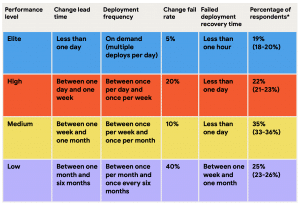The 2024 DORA Accelerate State of DevOps Report is packed with insights that can reshape how tech teams work. This year, the spotlight was on the impact of AI and the changes it has brought to software engineering. I’ll give you an overview of the key points so you can decide if it’s worth diving into the full report.
In 2024, AI adoption in engineering teams and the rise of platform engineering were major highlights, introducing practices and reflections essential for those looking to stand out in a fast-evolving landscape.
Here’s a quick breakdown for you. Let’s dive in!
Survey Participants for the DORA Accelerate State of DevOps
To create the 2024 DORA report, over 39,000 professionals worldwide shared their experiences. Participants included developers, tech leaders, platform engineers, data scientists, and many others involved in the software development lifecycle. This broad participation helps provide a clear snapshot of what’s happening across industries and different types of companies.
One new addition this year was more in-depth interviews, alongside the traditional quantitative survey. This approach gave DORA richer insights and revealed nuances that numbers alone often miss, adding another layer of reliability to the findings and offering a deeper understanding of the dynamics within tech organizations.
Software Performance Factors
The report emphasizes the importance of the well-known DORA Metrics for measuring team performance: Lead Time for Changes, Deployment Frequency, Change Failure Rate, and Mean Time to Recovery. Elite teams excel in all four, and the report shows that, despite different challenges, improving performance is possible across any industry.
One interesting discovery was the strong link between high change failure rates and rework. Teams facing frequent issues in deployments spend more time fixing problems, directly impacting their ability to deliver value quickly and consistently.
Performance Level Benchmarks
The DORA report also provides a detailed breakdown of team performance levels using the DORA Metrics. It identifies four levels: Elite, High, Medium, and Low. These benchmarks help teams understand where they stand in the market and how they compare in software delivery practices.

- Elite Level: Teams with a lead time of less than a day, deploying on demand, with a 5% failure rate and recovery time under an hour. Only 19% of teams reached this level in 2024, underscoring how tough it is to maintain peak efficiency.
- High Level: Teams with a lead time between one day and one week, deploying daily to weekly, with a 20% failure rate and recovery within a day. Around 22% of teams fall into this category.
- Medium Level: Teams taking between one week and one month for changes, deploying weekly to monthly, with a 10% failure rate and recovery within a day. This group accounts for 35% of participants.
- Low Level: Teams with lead times of one to six months, deploying monthly to every six months, with a 40% failure rate and recovery time between a week and a month. Roughly 25% of teams fall into this level.
These benchmarks help teams spot improvement opportunities and set realistic goals. The report highlights a shift in focus from just aiming for “elite” status to embracing a mindset of continuous improvement, aiming for gradual progress instead of chasing labels.
The Impact of AI Adoption
A major focus of the 2024 report is how AI adoption is affecting development teams. AI is now a reality across multiple phases of software development. The report shows AI is boosting productivity, improving workflows, and enhancing job satisfaction for many developers. It’s also positively impacting code quality, internal documentation, and review processes.
However, the report also identifies challenges. Some teams reported a decline in software delivery performance and stability after adopting AI. One theory is that faster code generation might lead to larger change packages, increasing instability and the likelihood of failures.
The Rise of Platform Engineering
Another trend explored in the report is the growth of platform engineering. The idea is to create internal platforms that allow developers to focus solely on coding while the platform handles repetitive tasks, such as infrastructure provisioning and automated testing. This approach significantly boosts productivity, with some teams seeing a 10% performance increase by using internal platforms.
However, the report points out some drawbacks. While platform engineering enhances productivity, it can also slow down throughput due to the extra steps required for changes to pass through the platform, adding some bureaucracy to the process.
How Context Impacts Team Performance
The report emphasizes that the context in which a team operates affects performance. Teams with shifting priorities tend to struggle with lower productivity and higher burnout rates. Stable priorities are essential to maintain good performance and prevent burnout.
The study also highlights the importance of transformational leadership. Leaders who inspire their teams, provide vision, and support personal growth enhance both team performance and job satisfaction. This kind of leadership not only motivates teams but also aligns daily activities with the organization’s strategic goals. When teams have clear priorities and strong leadership support, they are more likely to achieve consistent, high-quality performance.
Organizational culture plays a critical role too. Teams working in environments with a culture of psychological safety—where members feel safe to take risks, make mistakes, and learn—tend to be more resilient and innovative. This safety encourages open collaboration and helps teams tackle challenges more effectively, boosting performance and reducing burnout.
AI and Meaningful Work: A Complex Relationship
The report reveals an intriguing aspect: while AI boosts productivity, it doesn’t necessarily help developers spend more time on meaningful work. By speeding up some tasks, AI creates extra time, but that time doesn’t always translate into more valuable activities. This paradox shows that even with automation, we need to rethink how to use our time effectively to maximize value.
To ensure AI delivers lasting value, leaders and teams need to define how freed-up time will be used. Without a plan to reallocate that time productively, efficiency gains can get lost in low-impact tasks. Teams that identify ways to use extra time for innovation, skill development, or solving complex problems reap the most benefits from AI adoption.
Balancing automation and creativity is also crucial. AI excels at repetitive and predictable tasks, but meaningful work—like critical thinking, creativity, and innovation—remains the domain of humans. A strategic approach to AI should go hand-in-hand with a culture that values creativity and encourages developers to use their human skills alongside technology.
Focus on Continuous Improvement
Like in previous years, DORA stresses the importance of a continuous improvement mindset. This means constantly evaluating processes, identifying improvement areas, and experimenting with new ideas. Teams that invest in continuous improvement and have mechanisms for feedback are the ones that achieve the best long-term outcomes.
Continuous improvement requires regular cycles of learning and adaptation. A key part of this is using retrospectives and reviews to reflect on what worked and what didn’t. These meetings help teams fine-tune processes and try new approaches. Experimentation is encouraged, as small tweaks can lead to significant gains in efficiency and quality.
Transparency is also vital for continuous improvement. When team members have clear access to performance data—like DORA Metrics—and understand the impact of their actions, they become more engaged and collaborative in achieving common goals. Creating an environment where everyone feels empowered to suggest improvements fosters active participation in process evolution.
Applying the Insights to Your Team
The DORA Accelerate State of DevOps results show that while technology evolves quickly, the fundamentals of software engineering success remain the same: user focus, continuous improvement, and effective leadership. AI adoption offers great potential, but it needs to be managed carefully to avoid sacrificing quality for speed.
Experimenting with new technologies is essential, but it’s equally important to critically assess their impact and adjust processes as needed. Using DORA Metrics continues to be an effective way to measure performance and strive for continuous improvement.



